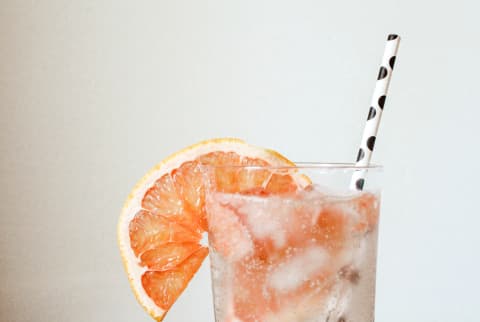Advertisement
Biodegradable Straws: What They're Made Of, Why They Matter & Where To Get Them


Single-use plastic straws are quickly falling out of style as people recognize them for what they are: wasteful, unnecessary, and environmentally damaging.
Since momentum built around the fact that single-use plastic straws play a major part in polluting our land and waterways because they aren't recyclable, Seattle, Malibu, and the United Kingdom have banned them from public establishments, Starbucks has opted to take them out of cafes, and American Airlines will no longer offer them on flights. American Airlines goes through an estimated 22 million plastic straws a year; Starbucks up to 2 billion.
While the straw movement might seem insignificant when you think about all the other plastic clogging our environment, any progress is good. And this large public shift proves that sweeping sustainable change can happen, more or less, overnight. Plus, our environment isn't the only beneficiary of these recent bans: Reusable and eco-friendly straws are now more in vogue than ever before.
"At this moment, the global PLA [plant-based plastic] and paper straw market is very stressed, and product delivery has been delayed across the board," David J. Fridland, who works on sustainability for food service provider Eco-Products, says. "We view this as an extremely positive trend that will get more and more brands and companies on the zero-waste journey." Some estimates place the increased demand for straw alternatives as high as 5,000 percent in recent months.
So what do you need to know to change your sipping habits? Let's take a look at the next iteration of straws.
First of all, why are plastic straws so bad?
Plastic waste has become all but ubiquitous around the world (each year, we toss enough plastic to circle the earth four times over), and according to the National Oceanic and Atmospheric Administration, plastic straws are one of the top five most common items found on our shores during International Coastal Cleanups. That's because they are super small and can easily evade trash cans, plus their shape and size make them difficult to recycle curbside.
However, things are starting to look up. Earlier this year, Jenna Jambeck, associate professor and researcher of plastic debris at University of Georgia and National Geographic Explorer, told mbg of the plastic pollution problem: "We have made so much progress in the science, policy, and level of awareness around the world. I am truly optimistic that the world will come together to work toward solutions to this problem, and we will make local and global changes to address it. And if we do work together locally and globally, then maybe that means we can work toward solving even bigger problems, too."

What does it mean if a straw is biodegradable?
Signs of this change have taken the form of plant-based straws—ones that, unlike petroleum-based plastics, don't take thousands of years, and a handful of toxins, to return to the earth. The term "biodegradable" is a catchall that means something is capable of breaking down, but the word "compostable" is more specific. "An aluminum can is 'biodegradable'—if you wait 200 years," explains Fridland. "In contrast, 'compostable' means something will break down in a reasonable amount of time, leave behind no toxic residue, and safely become an additive to soil."
However, just because a straw is compostable doesn't mean it can be thrown into your home compost bin to be turned into soil for your backyard. Confusing, I know! If a box of straws is marked with a recycling number 7, they are likely PLA (Poly-Lactic Acid), a type of plastic that is made from corn or sugar cane instead of petroleum that is too finicky to compost at home. They must be sent to a large-scale facility that conducts more heat to break down trash into nutrients. Like plastic straws, you should NOT recycle these, tempting as it might be, because they can clog the process.
So while biodegradable and compostable straws are capable of returning to the earth eventually, the timeline is sometimes murky. Any natural material is capable of naturally breaking down as long as there aren't additives like lacquers, glues, or coating. If a straw is certified by the BPI Label, it is compostable within 180 days in a large-scale facility.
What are biodegradable straws made of?
PLA is one of the most commonly found plastic straw substitutes these days, but you can now find straws made from paper, bamboo, and grain, too—all of which have varying levels of biodegradability.
Some straw brands made from materials that are more eco-friendly than conventional plastic straws include Eco Products made from PLA, Turtle Buddy made from PLA, Aardvark Straws made of paper, Preserve Straws made of paper, Harvest Straws made of grain, and Bambu Straws made of—you guessed it—bamboo.
What other kinds of straws are out there?
Reusable straws (some of which are biodegradable too, like Bambu) are another option. Brands like Simply Straws (made of glass) and Klean Kanteen (made of metal) are pumping out straws meant to be reused again and again, and these days even Tiffany's is offering a luxe sterling silver alternative to the tune of $250 if you really want to slurp down that matcha latte in style.
Here are a few more reusable straw alternatives to check out.
Watch Next
Enjoy some of our favorite clips from classes
Enjoy some of our favorite clips from classes
What Is Meditation?
Mindfulness/Spirituality | Light Watkins
Box Breathing
Mindfulness/Spirituality | Gwen Dittmar
What Breathwork Can Address
Mindfulness/Spirituality | Gwen Dittmar
The 8 Limbs of Yoga - What is Asana?
Yoga | Caley Alyssa
Two Standing Postures to Open Up Tight Hips
Yoga | Caley Alyssa
How Plants Can Optimize Athletic Performance
Nutrition | Rich Roll
What to Eat Before a Workout
Nutrition | Rich Roll
How Ayurveda Helps Us Navigate Modern Life
Nutrition | Sahara Rose
Messages About Love & Relationships
Love & Relationships | Esther Perel
Love Languages
Love & Relationships | Esther Perel











